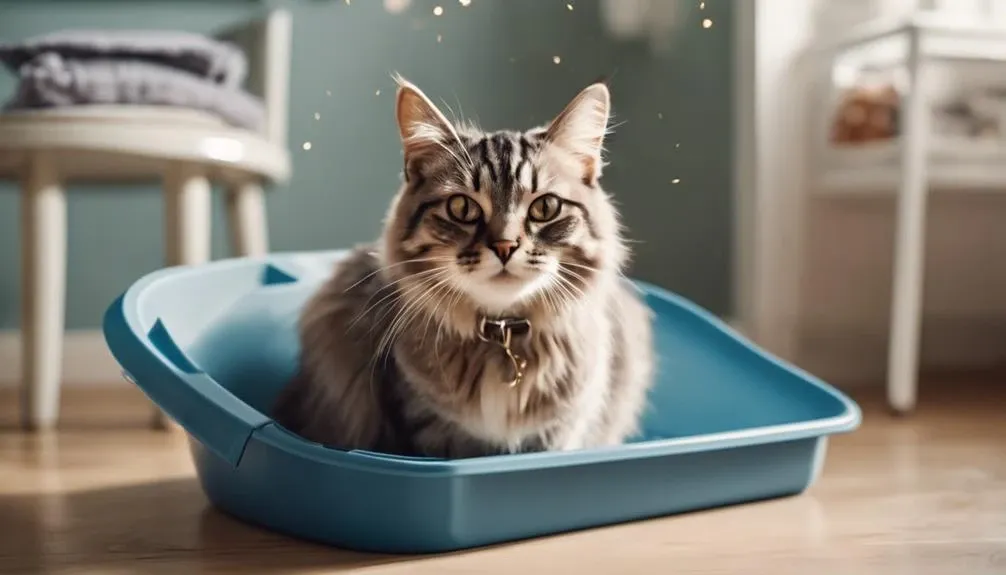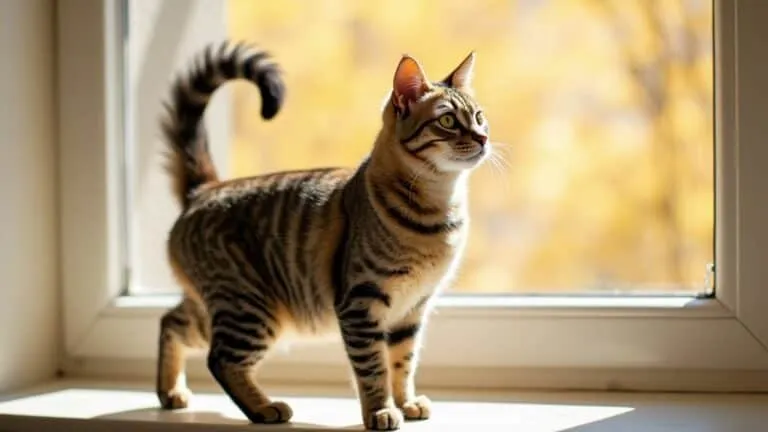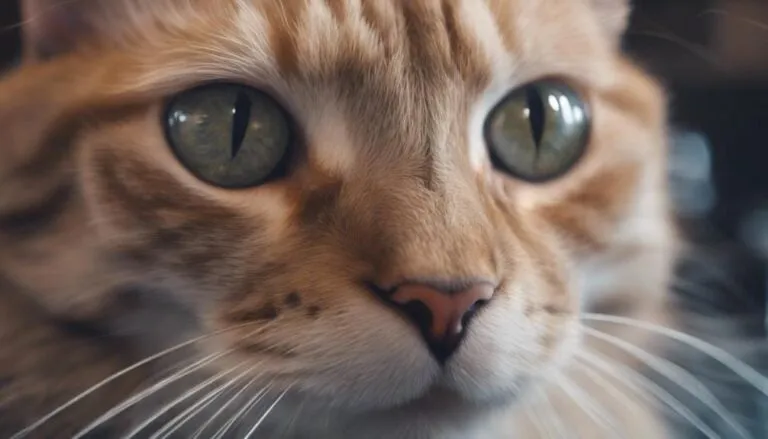The Best Fluffy Pancakes recipe you will fall in love with. Full of tips and tricks to help you make the best pancakes.

Embarking on the journey of potty training your cat is like building a bridge to a new level of feline independence. As you start the process, remember that patience and consistency are key to your success.
Each step in the training plan plays a crucial role in shaping your cat's behavior. By gradually introducing changes and celebrating small victories, you pave the way for your cat to master this essential skill.
But what happens when setbacks occur during the training process? Stay tuned to discover effective strategies and tips to navigate through potential challenges smoothly and ensure a successful outcome for both you and your cat.
Key Takeaways
- Gradually transition from litter box to toilet.
- Use positive reinforcement with treats and catnip.
- Avoid teaching your cat to flush the toilet.
- Consistently reward good behavior and maintain litter box hygiene.
Setting Up the Training Area
When setting up the training area for potty training your cat, ensure you choose a quiet and accessible bathroom. This space will provide the necessary privacy and tranquility for your cat to feel comfortable during the litter box training process. Make sure the litter box or training seat is stable and secure on the toilet to avoid any accidents or scares. Using flushable litter in the training seat will make cleanup easier as you progress through the toilet training process.
During the training process, it's essential to monitor your cat's behavior closely. This will help you gauge their comfort level and adjust the training accordingly. Gradually raising the litter box or training seat to the height of the toilet seat will help your cat get accustomed to using the actual toilet. By following these steps and being patient and observant, you can successfully toilet train your cat.
Introducing Your Cat to the Toilet
To smoothly introduce your cat to the toilet, begin by gradually moving the litter box closer to the toilet each day to help acclimate your feline friend to the new location. As your cat becomes comfortable with this transition, you can start using a thin layer of litter in the box and position it directly over the toilet seat. This method will aid in getting your cat accustomed to the idea of using the toilet for elimination.
Training Tips Table:
| Step | Description |
|---|---|
| Reduce Litter Depth | Gradually decrease the amount of litter in the box to encourage toilet use. |
| Replace with a Training Box | Swap the litter box for a training box that can support your cat securely. |
| Add Catnip and Treats for Encouragement | Incorporate catnip in the litter and reward your cat with treats for success. |
Gradual Transition to Toilet Training
To ensure a smooth transition to toilet training for your cat, begin by gradually moving the litter box closer to the toilet each day. This gradual adjustment will help your cat acclimate to the new location and reduce any potential stress.
Slowly Introduce Toilet
Gradually transitioning your cat to using the toilet involves moving the litter box closer each day while reducing the litter depth until it can be positioned directly over the toilet seat.
To smoothly introduce the toilet to your cat, follow these steps:
- Move the litter box closer daily: Help your cat get accustomed to the new location.
- Thin layer of litter: Place a small amount of litter in the box as you progress.
- Reduce litter depth: Gradually decrease the amount of litter in the box.
- Use a training box: Switch to a training box that can hold your cat's weight.
- Clean and reward: Keep the training box clean, add catnip, and reward your cat with treats for using it.
Patience Is Key
Moving forward in your cat's toilet training journey, the key to success lies in your patience and gradual approach to introducing the toilet as their new elimination spot. Start by transitioning from the litter box to a training box on the toilet seat, increasing its height gradually. Positive reinforcement, such as treats and catnip, helps create a positive association with the toilet. Monitor your cat's progress closely, adjusting the training pace based on their comfort and behavior. Consistency is crucial in successfully training your cat to use the toilet. Below is a table to assist you in understanding this gradual transition process:
| Step | Action |
|---|---|
| Litter Box | Begin with the litter box. |
| Training Box | Transition to a box on the toilet. |
| Positive Reinforcement | Reward with treats and catnip. |
| Progress Monitoring | Watch behavior and adjust training. |
Encouraging Toilet Use
Encourage your cat to use the toilet by transitioning from a litter box to a training box placed on the toilet. This gradual shift helps your cat become accustomed to using the toilet for elimination.
Here are some tips to assist you in encouraging your cat to use the toilet effectively:
- Positive Reinforcement: Use treats and catnip to reward your cat for using the training box, reinforcing the desired behavior.
- Gradual Hole Cutting: Cut a hole in the training box gradually. This step helps your cat get comfortable with eliminating directly into the toilet.
- Litter in the Toilet: Add litter to the toilet water. This can help your cat associate the smell with the litter box, encouraging toilet use.
- Avoid Flushing Training: Avoid teaching your cat to flush the toilet. Instead, focus on encouraging them to use the toilet consistently.
- Consistency is Key: Be consistent in your approach. Regular practice and positive reinforcement will help your cat learn to use the toilet reliably.
Rewarding Good Behavior
When potty training your cat, using small, tasty treats can be a powerful tool in reinforcing good litter box behavior.
Remember, timing is crucial – give treats immediately after your cat uses the litter box correctly to make a strong association.
Consistency in rewarding good behavior will help your cat understand what's expected and encourage them to continue using the litter box.
Treats for Success
To effectively reinforce good behavior in your cat, use small, tasty treats like freeze-dried chicken or fish when they use the litter box. Here are some tips to help you use treats successfully in potty training your cat:
- Treats should be given immediately after the desired behavior to reinforce the connection.
- Positive reinforcement with treats helps your cat associate using the litter box with a positive experience.
- Consistency in rewarding good behavior with treats will help establish good litter box habits.
- Gradually reduce treat rewards as your cat becomes consistently successful in using the litter box.
Consistent Positive Reinforcement
Consistent positive reinforcement plays a crucial role in shaping your cat's potty training behavior effectively.
When your cat successfully uses the litter box, immediately reward them with high-value treats like cooked chicken or tuna. This positive reinforcement helps your cat associate using the litter box with receiving a reward, strengthening their good behavior.
Remember, training takes time, so be patient and consistent in rewarding your cat for using the litter box correctly. Avoid punishing your cat for accidents; instead, focus on praising and rewarding them.
Timing Is Key
Rewarding good behavior promptly is essential in cat potty training to effectively reinforce desired actions. When it comes to cat potty training, positive reinforcement plays a crucial role in encouraging your feline friend to use the litter box consistently.
Here are some tips on how to time your rewards effectively:
- Immediate Reward: Give your cat a treat or praise immediately after they use the litter box correctly.
- Consistency is Key: Be consistent in rewarding good behavior to help your cat understand what's expected during potty training.
- Use Varied Rewards: Treats, praise, or playtime can all be effective rewards to motivate your cat.
- Positive Association: Positive reinforcement helps your cat associate using the litter box with positive outcomes.
- Encouraging Continuation: Rewards encourage your cat to continue using the litter box, making potty training a positive experience.
Monitoring Progress and Adjusting
Throughout the potty training process for your cat, it's crucial to closely monitor their progress and make necessary adjustments based on their behavior and reactions. Track how often your cat successfully uses the toilet, noting any accidents or signs of hesitation to adjust training methods accordingly.
Observing your cat's comfort level and body language when using the toilet can provide valuable insights into their readiness for the next steps in training. Keeping a log of progress will help you identify patterns or setbacks in the potty training journey, allowing you to make gradual adjustments based on your cat's responses.
Dealing With Setbacks
When faced with setbacks during your cat's potty training journey, promptly addressing them is essential to prevent reinforcement of unwanted behavior. Here are some steps to help you overcome setbacks effectively:
- Adjust the training schedule: If your cat gets off track, consider adjusting the training schedule to reduce the amount of pressure on your cat and allow for more gradual progress.
- Provide positive reinforcement: Encouragement and rewards for desired behaviors can help reduce setbacks and keep your cat motivated to continue with their potty training.
- Seek guidance from a veterinarian: If setbacks persist despite your efforts, consult with a veterinarian to rule out any underlying health issues that may be affecting your cat's ability to learn.
- Be patient: Remember that setbacks are a normal part of the training process, and staying patient and consistent will help your cat overcome challenges more effectively.
- Stay consistent: Consistency in your approach and expectations will help your cat understand what's required and reduce the likelihood of setbacks occurring.
Finalizing the Toilet Training
After overcoming setbacks in your cat's potty training journey, the final steps to solidify their toilet training involve gradually transitioning away from the training box and teaching your cat to eliminate directly into the toilet.
Start by cutting a hole in the training box, increasing its size gradually. Reduce the amount of litter in the box as you enlarge the hole, encouraging your cat to get used to the new setup. Once your cat is comfortable, remove the cover from the training box.
Your goal is to wean your cat off the box entirely, so continue to decrease the litter until your cat is using the toilet without it. Reward your cat for successful eliminations and remember to flush after each use to reinforce the desired behavior.
With patience and consistency, your cat will soon be fully toilet trained, making your life easier and keeping your home cleaner.
Maintenance Tips for Continued Success
To maintain the success of your cat's toilet training, regularly scoop the litter box to keep it clean and odor-free. It's essential to establish a proper maintenance routine to ensure your cat continues to use the litter box effectively.
Here are some tips for maintaining your cat's litter box:
- Scoop Daily: Removing waste daily helps keep the litter box clean and prevents odors from building up.
- Wash Bi-weekly: Washing the litter box every 1-2 weeks with mild soap and water maintains hygiene for your cat's health.
- Replace Litter: Regularly change the litter to maintain the appropriate size and depth, ensuring your cat's comfort.
- Monitor Behavior: Pay attention to your cat's behavior around the litter box for any signs of aversion or discomfort.
- Consult a Vet: If your cat consistently avoids the litter box despite proper maintenance, seek advice from a veterinarian to address any potential health issues promptly.
Celebrating Your Cat's Achievement
To celebrate your cat's successful toilet training journey, it's important to acknowledge and reward their achievements in a meaningful way. Rewarding your cat with their favorite treats immediately after successfully using the toilet is a great way to reinforce positive behavior. Additionally, offering verbal praise and gentle pets can further emphasize their accomplishment during the potty training process.
Creating a special celebration ritual can also be a fun approach to mark each milestone in your cat's toilet training journey. Consider incorporating a unique dance or presenting a special toy to make these moments memorable. Taking photos or videos of your cat using the toilet and sharing them with friends and family can also be a delightful way to celebrate your cat's progress.
As your cat continues to master using the toilet without any accidents, think about throwing a small party or getting a special gift to commemorate this significant milestone. By celebrating your cat's achievement, you aren't only acknowledging their hard work but also strengthening the bond between you and your feline friend.
Frequently Asked Questions
What Is the Easiest Way to Potty Train a Cat?
The easiest way to potty train a cat is through gradual steps. Begin by moving the litter box next to the toilet and using positive reinforcement. Transition to a training seat and monitor progress for successful training.
How Long Does It Take to Potty Train a Cat?
Potty training your cat can vary in duration, sometimes taking a few weeks for kittens or several months for older cats. Consistency, patience, and positive reinforcement are crucial. Monitor progress and adapt techniques accordingly for success.
Are Cats Easily Potty Trained?
Cats are easily potty trained due to their natural behaviors. You can train them by using proper methods and a litter box. With consistency and positive reinforcement, your cat will quickly learn to use the designated area.
How Do I Teach My Cat Where to Pee?
To teach your cat where to pee, start with litter box training. Use positive reinforcement such as treats and praise. Keep the indoor cat potty clean. Monitor behavior and adjust training methods as needed for successful results.
Conclusion
In conclusion, potty training your cat in 10 easy steps is a manageable process that requires patience, consistency, and positive reinforcement. By following these steps, you can create a smooth transition for your feline friend from using a litter box to the toilet. It’s essential to remain calm and celebrate small victories throughout the process. If you’re wondering how to train your cat effectively, remember that every cat learns at their own pace, so adjust your approach as needed.
By following the outlined steps and adjusting to your cat's progress, you can successfully teach them to use the toilet for their bathroom needs.
Remember to celebrate your cat's achievement and continue to maintain their training routine for long-term success.
With dedication and guidance, your cat can become a toilet-trained companion in no time.








